Künstlerische Leitung: Mareen Alburg Duncker.
Special school Astrid Lindgren, Halle (Saale)
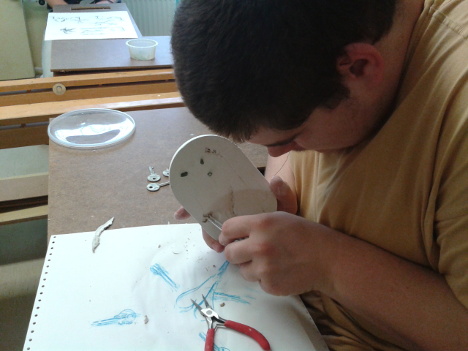
In this project, the pupils worked with plants from the garden directly at the special school and from the school garden, which they cultivate. To get a different perspective on the sometimes very complicated shapes in nature, we took a closer look at Karl Blossfeldt’s photographs together. We wanted to realize the graphic effect of the photographs using the frottage technique. Das anfängliche Zögern wechselte in Begeisterung beim Anblick der entstandenen Abdrücke. Colors were combined, plant parts placed on top of each other, worked very dynamically. But there were also “quiet” graphics, on which very delicate outlines of sage leaves can be seen. In the course of the course we wanted to arrive at object-like forms in which the plants can also be found as images. Flowers and leaves were positioned in shallow bowls. Now the pupils carefully poured in the liquid relief casting compound. After curing, the plant parts visible on the surface were partially and carefully removed with tweezers and pliers. The negative print appeared as a relief. Image plates have been created that are reminiscent of a fossil find. After learning the casting technique, the students were asked to work according to the same principle but with a different material. The tireless mixing of colors resulted in a broad palette of bright soaps with inclusions of dried plant parts.
Künstlerische Leitung: Mareen Alburg Duncker.
Förderschule „Astrid Lindgren“, Halle (Saale)
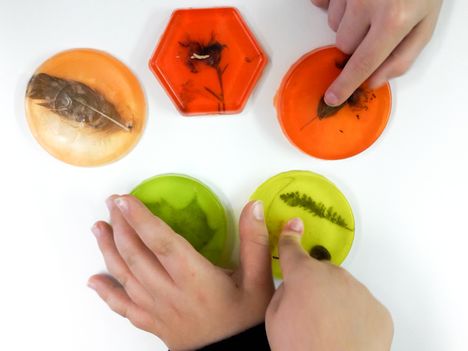
Unter dem Titel „Farbe – gedruckt und gegossen“ leitete Mareen Alburg Duncker erstmals einen Kurs mit Schülern der ersten Klasse in der Förderschule „Astrid Lindgren“. Da die Konzentrationszeiten noch niedrig waren, haben wir in aufeinanderfolgenden kurzen Intervallen gearbeitet. Im ersten Turnus erforschten die Kinder spielerisch die grafische Wirkung von farbig gedruckten Pflanzenteilen. Mit Pinsel und Acrylfarbe wurden die Farben auf die im Schulgarten gesammelten Blätter aufgetragen und diese dann auf Papier abgedruckt. Das anfängliche Zögern wechselte in Begeisterung beim Anblick der entstandenen Abdrücke. Farben wurden kombiniert, die Mischtechnik erprobt, Pflanzenteile übereinander gelegt. Die Schüler arbeiteten sehr dynamisch. In der zweiten Kurshälfte verwendeten wir zuvor getrocknete Pflanzenteile. Diese dienten als gestalterisches Mittel beim Erlernen der Technik des farbigen Seifengusses. Hierbei waren die feinmotorischen Fähigkeiten genauso gefordert, wie Geduld und Vorstellungskraft. Durch die Transparenz der Seife sind die Intarsien (Blätter, Blüten und sogar Eichelhütchen) schön zu sehen und erinnern an Einschlüsse im Bernstein. Das Ergebnis war sehr beeindruckend. Die entstandenen Seifen können natürlich benutzt werden, wobei sie auch als Bildobjekte funktionieren.
Künstlerische Leitung: Claudia Berg.
Elementary school, Siersleben

I made a memory card game with Year 2 pupils from Siersleben Primary School by drawing animals and mythical creatures from facsimile prints of the copperplate engravings from Bertuch’s 18th century “Picture Book for Children”. A found motif had to be repeated after the first drawing. This resulted in wonderful pairs of cards, which we then tried out in the classroom.
Artistic director: Christiane Budig.
Elementary school “am Mühlberg”, Hohenthurm

Using slides they created themselves, the pupils staged a color space experience. The pupils were given the opportunity to experiment freely and explore creative effects (e.g. color mixtures, color attraction of thread or salt, etc.) with various small materials that they found in the household or in nature, such as grasses, salts, yarn, cling film, etc. and inks or glass paints. Color knowledge in the area of color mixtures was deepened through experimentation, and design issues were dealt with through their own actions (e.g. surface – line relationship). The starting point for the designs was free experimentation and subsequent association. Unique and individually designed slides were created. The students were just as individual with their preferences, favorite colors and joys of experimentation. The pupils’ imagination was given wings in the project and they playfully used their creativity to create pictures. The students’ feedback on the project days was consistently positive. Performative actions (video recordings and a photo shoot) complemented the miniature painting. The project ended with a presentation.
Künstlerische Leitung: Marija Falina.
Giebichenstein Grammar School, Halle (Saale)

New and familiar places were explored and opened up from different angles, such as the State Museum of Prehistory, the Rosenburg Art Café, Reichardt’s Garden and Giebichenstein Castle – always with the sketchbook. With the help of drawings, collages and texts, the pupils explored and reflected on what they had seen and experienced.
Künstlerische Leitung: Carola Helbing-Erben.
Ostrau Castle Primary School, Ostrau

“My cat and artists’ cats”. The theoretical part of the working week included initial art-historical insights into letterpress printing and the first printing processes in general. This was followed by pictures of well-known artists and their depictions of cats. We worked in linocut. From design to printing, everything was in the child’s hands. At the end of the project, the children’s art cats from Ostrau were a hit.
Künstlerische Leitung: Carola Helbing-Erben.
Special school for the mentally handicapped “Astrid Lindgren”, Halle (Saale)
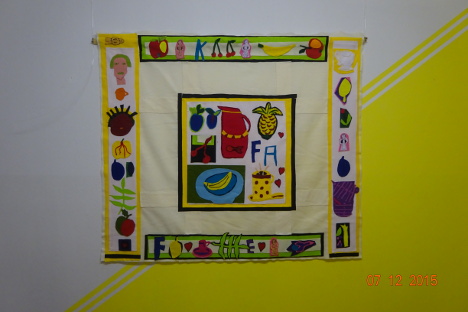
The students of the vocational school run a small café in the school building, which was already decorated and furnished. Their wish was to make this coffee shop more appealing and attractive to visitors by designing the walls. We created two tapestries and a “Coffee Banana” plaque, a title that the pupils chose themselves. The design work and execution was conceived as individual and joint work. The material of the rugs is felt.
Künstlerische Leitung: Holtrud Helene Henze.
Secondary school, Könnern

Self-portrait as a collage – that‘s me with my hobbies, dreams and wishes… At the beginning, the topic was discussed and then material was collected. There were shells, leaves, scraps of paper, fabric and leather, twine, pieces of wood, glittering stones and feathers. To start with, each pupil drew their portrait “blind”. The often astonishing results facilitated access to the “big picture”. Almost everyone was eager to put together their collage or portrait on the 35×50 cm cardboard.
Artistic direction: Björn Hermann and Rebekka Rauschardt.
Diemitz/Freiimfelde elementary school, Halle

At the “Sequin Palette” workshop, 19 girls and boys from Year 3 spent a week designing and sewing their own dresses, hats, bags and fashion accessories using a wide range of fabrics and a large selection of buttons, beads and strings – creativity, sensitivity and sensitive fine motor skills were required. The emotional highlight and conclusion of the project was a fashion show in the school gym, where the other classes watched and applauded enthusiastically.
Künstlerische Leitung: Jörg-Tilmann Hinz.
Special school for the mentally handicapped “Astrid Lindgren”, Halle (Saale)

Pupils at the Astrid Lindgren School in Halle, some of whom have multiple mental and physical disabilities, are prepared for life after leaving school within their individual capabilities and limitations. It is important for them to gain practical and creative experience in addition to the academic and social learning content and to achieve visible results. The individual success is often surprising. In the so-called upper school, the task this year was to design flags, a very personal one made of paper with free forms and colors, a weather vane made of cardboard and finally a flag cloth designed with the help of spray paints in connection with overlapping stencil forms.
Artistic director: Christiane Jung.
Elementary school, Klobikau

The two murals created by previous generations of pupils in and around the school prompted the children to ask to immortalize themselves in their primary school in this way. The wall of a sloping roof in the reading aloud corner next to the school library was proposed.
Künstlerische Leitung: Suse Kaluza.
Gotthold Ephraim Lessing Primary School, Halle (Saale)

Red Blue Yellow – Mix colors. What happens when two colors mix? In this art project, we got to the bottom of this question. Using the three primary colors magenta (red), cyan (blue) and yellow , we explored the world of colors. White and black were also allowed to play along and so we could see which pictures the colors persuaded us to create!
Künstlerische Leitung: Claudia Klinkert.
Saaleschule for (H)all, Halle (Saale)

For a ceramics project at the Saale School, I worked with an eighth and a seventh grade class for a week each on the subject of “Underwater World”. In the run-up to the project, the pupils created sketches for the future murals in regular art lessons. During the project week, I taught the pupils how to cut out large panels and create a sculptural relief on them. For the most part, the students worked together in groups, which allowed them to engage in a lively exchange regarding the execution. Afterwards, the students colored their work in my workshop. The works of art now adorn the foyer and staircase of the Saale School.
Künstlerische Leitung: Juliette Kolberg.
Franziskus Primary School, Halle (Saale)

Where are you dreaming of? The journey into a landscape was at the forefront of this project. Everything became possible. For some, it was the ice surface in the desert or the jungle on the mountain and the Antarctic in the valley, the pink lake next to the ski lift that leads to the sea in the heights. For others, however, …. was And how do you present that?
Artistic director: Annekatrin Müller.
Special school “Lebensweg” of the Salzland district

Two groups were formed for the project, depending on ability and age. The big topic was agriculture. The first group spent two days creating a plaster relief. A negative cast was taken from a clay relief using plaster. This was poured out again and the negative mold was knocked off. The second group used two project days to get to know graphic techniques such as monotype, frottage and cardboard printing etc.
Artistic director: Susanne Nickel.
Wittekind elementary school, Halle
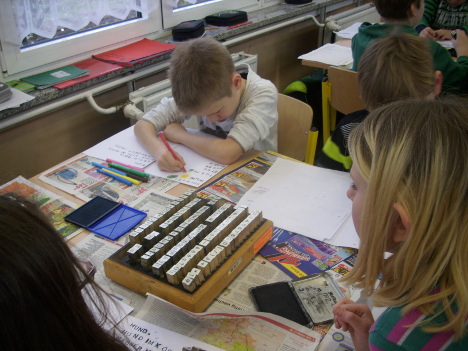
People’s knowledge is preserved forever in books. But this was not the case many thousands of years ago. People took their knowledge with them to the grave when they died. Because they couldn’t write. There was no alphabet. There was no writing. There were no books either. That’s why the language was very simple. People said almost nothing or very little, in short sentences. A few hundred words were enough for her life. It took thousands of years for language to develop, until mankind kept inventing new words. At some point in the course of time, writing was invented. Inspired by Feininger’s contributions to the “Lustige Blätter”, the children themselves created a work combining images and writing – a book. The children thought up words and even a story, printed them with stamped letters and drew pictures to go with them. The pages were folded for a book and the text arranged on the page. The book covers were designed. The children were able to find their own rhythm and imagination. They were free to decide, change and try things out.
Künstlerische Leitung: Karl Oppermann.
Marianne Buggenhagen School, Darlingerode

Mixing techniques were tried out in the “Butterflies” project. Different effects of different materials should be experienced and concentration and tension should be maintained for up to 2 ½ hours during the various work steps. The intention of the project was to familiarize the children with a wide variety of working techniques on a catchy topic. We chose the theme “Butterflies”. Three different approaches should each lead to the goal. The mixing of techniques served not only to motivate, but above all to activate creativity through multiple methods of representation in contrast to fixed techniques such as watercolor or pastel.
Artistic director: Karoline Peisker.
After-school care center of the Montessori School, Halle (Saale)

It all began with a climb to the altar of the main building of the Francke Foundations. Inspired by this, the children created a Christmas mountain in several workshops with a lot of imagination and dedication. In the end, it was an intense artistic exploration of the immediate surroundings for everyone.
Artistic director: Annekathrin Pohle.
Bildungsmanufaktur, Halle (Saale)

In the course, the students designed multi-part jewelry and picture panels. After an introduction based on existing enamel works and illustrations from different eras, designs and their realization followed. Using test panels and experimental pieces, they gained initial experience with different types of enamel and application and then implemented their own ideas. The students made the copper molds themselves and added colors and patterns to them using various techniques such as stenciling and scraffito. Some of the students insisted on trying out the technique of bar enameling. They mastered this test of patience with flying colors.
Künstlerische Leitung: Renée Reichenbach.
Levana School, Eisleben

Working with special needs students is always an adventure in the sense that you experience the unknown, the unsettling and the exhilarating. Plus creativity and productivity, absolute honesty in our work and in our dealings with each other. On the subject of vessels, a series of different bowl and ball shapes were created in plaster molds from various clays and colored porcelain.
Künstlerische Leitung: Katrin Röder.
Riesenklein Education Center, Halle (Saale)

In this project, the pupils were asked to research various animals and turn them into appliqué embroidery. They ranged from exotic animals such as the red tube spider to pets such as the Bernese mountain dog. Wild stitches banned fabric remnants and were supplemented with fiber pencils.
Artistic director: Barbara Šalamoun.
Levana-Schule, Eisleben

The project “Introduction to comic design” was carried out over two days. Working with mentally and physically disabled children, the aim was to go through the path of the picture story with them. The important thing, as with all beginners, was to lay the foundations of the comic. Creating the beginning and end of the story, the character/the main character, how does the writing in the bubbles work. It turned out that with these children it is important not only to pose the topic, but also more or less to think it out for them. Show them examples and have them retell them, or have them look for the important points in them. First of all, they have to draw the figure based on real people. Without this, they have no point of reference, just like healthy children. They don’t realize that a person has two eyes to see from the front and only one from the side, that the nose is in the same place but looks different from the side than from the front. The font had to be prescribed. Nevertheless, the results are very pretty.
Artistic director: Dietmar Sauer.
Evangelische Sekundarschule, Magdeburg

The pupils got together in groups and worked together to develop an idea concept for a land art project. They collected materials and developed a drawing or painting template. The following definition was the starting point: “The natural space and the objects within it are rearranged by artists and placed in an artistic context, whereby the landscape becomes part of the art, not just as a beautiful background, but in symbiosis with the materials. Depending on the type of installation, the works of art are only visible for a limited period of time due to weather and other environmental influences before they return to the cycle of nature.” Changing the geographical situation by implementing projects in the school environment using natural materials wherever possible, understanding graphic-painting contexts and recognizing the existing transience of these works of art was part of the project content. It was observed that, with a few exceptions, the class developed an identification with their work and that the groups began to see their ideas as group work. The aim of this work was also to create a concept for the completion of the work. Some of the students worked completely independently and in a results-oriented manner.
Artistic director: Stefan Scholz.
Burg-Gymnasium, Wettin
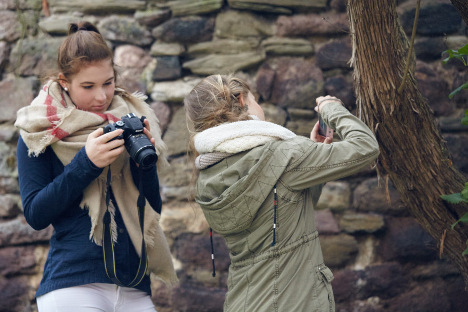
How do the school buildings fit into your own perception? What colors, textures and materials are available? How do the old walls of the Burggymnasium contrast with the new buildings? The pupils experimented with their personal perception of their school space and recorded their impressions and findings in photographs.
Künstlerische Leitung: Silke Trekel.
Grundschule, Salzmünde

On the occasion of the 500. On the occasion of the 100th birthday of Lucas Cranach the Younger, we embarked on a journey through Renaissance painting under the motto “A jewel for Cranach” and explored the paintings of the Cranach family. Many of Cranach’s paintings show portraits of councillors, women and their daughters wearing precious jewelry, which in the 16th century primarily symbolized the social status of the wearer. In our project, we looked at the jewelry in Cranach’s paintings and reinterpreted it. Adorning oneself has a completely different meaning today than it did in the Renaissance, as it is much more about discovering one’s own identity. Glitz and glamor, wealth and status tend to play a subordinate role. Together, we created jewelry with various materials such as iron wire and beads using simple techniques – folding, bending and assembling. We approached the topic in a playful way and were inspired by the works of Cranach.
Artistic direction: Klaus Dieter, Rosemarie and Pauline Ullrich.
Secondary school Campus Technicus, Bernburg

Colored reliefs made of gas concrete with mounted wire bending work were created on the theme. Three artists each worked intensively on the theme of the “facial landscape” in three sub-aspects: Metal/wire bending work (with Rosemarie Ullrich), coloring and painting/graphics in design and elaboration (with Klaus Dieter Ullrich), design of the reliefs in gas concrete (with Pauline Ullrich). All three working methods enriched each other and enabled a special, interesting result in terms of content and material.
Artistic direction: Pauline Ullrich.
Elementary school, Beesenstedt

With the “Harry Potter and the Chamber of Secrets” project, it was particularly important to me to stimulate the imagination – especially for this age group (3rd grade). The book “Harry Potter and the Chamber of Secrets” served as both an aid and a model for ideas of flying cars, phoenixes, snakes and giant spiders. Collecting materials, selecting them, sticking them together and using them to create their very own world of images visibly had its own “magic” for the children.
Künstlerische Leitung: Uwe Wendler.
Willy Brandt integrated comprehensive school, Magdeburg

Art course 12th grade FORMS OF NATURE. Against digital overload Engaging with the real world by collecting natural objects. After evaluation, production of small clay tablets (shaping, glazing, firing) as a preliminary exercise. From this, free design of natural forms in clay, painting with acrylic paints, compiling the results on a large blackboard. Meaning: we are real beings in a real world and do real work both with our heads and with suitable tools by hand.
Künstlerische Leitung: Uwe Wendler.
Hegelstraße elementary school, Magdeburg

The project took place outside of school, eight children, mainly 2nd grade, with the special feature of six different ethnic origins: one each from Greece, Iran, Kosovo, Russia, Belarus and three from Germany. The theme was decorating a dining room with pictures, which were conveniently painted on panels and then attached to two walls. The main content of each picture is the reference to the origin, i.e. expressing all essential things of the ethnic homelands such as landscapes, architecture, culture, habits and others. Spiced up with fairy tales, legends, fantasy and lots of fun. Work was carried out in four groups that had formed automatically in “best friend mode”.
Künstlerische Leitung: Ines Zimmermann.
Makarenko School (special school for the learning disabled), Halle (Saale)

On the theme of the seasons, the pupils were able to put their creative ideas into practice using various techniques – such as painting with acrylic paint, trying out a printing technique, coloring watercolor paper with colored foam and designing with stencils. They created flower pictures for the spring motif, butterflies for the summer, owls for the fall and ice crystals for the winter picture.
